Over the years, owing to rapid technological progress, radiation from man-made sources has overcome to that of natural origin. One such radiation is microwaves. Microwaves are waves with wavelengths ranging from as short as one millimetre to as long as one meter. The study of electromagnetic phenomena such as reflection, refraction, diffraction, polarization, and absorption is of significant consequence in the study of how these waves move in space and time. Microwaves are particularly suitable for the use since they are more easily focused into narrow beams than radio waves as they have relatively higher frequencies which allow broad bandwidth and high data flow. Microwaves may have both positive and negative effects on Aloe Vera plant. The investigation was carried out with Aloe Vera Leaf exposed to microwaves. Images of the exposed Aloe Vera Leaf as well as normal leaf were taken and texture, colour, as well as growth were studied for ten days. It was found that on exposure to microwaves the Aloe Vera Leaves did not showed any significant change in texture but the colour of the leaf was changed slightly from natural green to yellowish green. The growth of the leaf was affected significantly and showed some decrease in the length.
Keywords |
| Aloe Vera, effect of microwaves, klystron, microwave test bench. |
INTRODUCTION |
| Microwaves are non-ionizing radiations which are the part of the electromagnetic spectrum. Its wavelength spans
from 1 m (300 MHz) to 1 mm (300 GHz). Microwaves do not contain adequate energy to chemically alter substances
by ionization, and so it is an example of non ionizing radiation. Electromagnetic radiation of frequency in the tens of
MHz range and below cannot penetrate the ionosphere where as microwaves can. A number of studies have been
carried out to investigate their effect on the plants and animals. Anna Aladjadjiyan [1] investigated the influence of
microwave irradiation treatment on the development of lentil seeds. Some, but not all, studies suggest that long-term
exposure may have a carcinogenic effect [2]. The plants play a significant role for living beings, as they are the primary
producers of food and oxygen. They also consists of complex and well-organized both conductive and insulated
elements. Therefore it is necessary to examine their interaction with increased exposure to radio and microwave
frequencies [3]. Microwaves can affect the both animals and plants. Most common applications of microwaves are
within the 1 to 40 GHz range. It is due to skin effect at these microwave frequencies that a piece of glass with an
evaporated silver coating 5.40 μm thick is an excellent conductor at microwaves [4]. Radio Society of Great Britain
(RSGB) has categorized the different regions of microwaves in the bands listed in Table I. Microwaves consist of
electric and magnetic field perpendicular to each other, propagating together in the same direction. Microwave
conduction may vary from plant to plant as plants comprise of complex and well-ordered both conductive and insulated
elements. Microwaves also have an effect on soil moisture, which is a significant component of the hydrology of land
surfaces [5]. The new and energetic area of scientific research is the studies associated to the microwave effects.The
objective of this paper is to investigate the effect of microwaves on the texture, colour as well as on the growth of the
Aloe Vera plants. The Aloe Vera has been chosen because of its numerous applications. The details of Aloe Vera are
presented in Section II. The methodology is given in Section III and results and discussions in Section IV along with
the conclusion in Section V. |
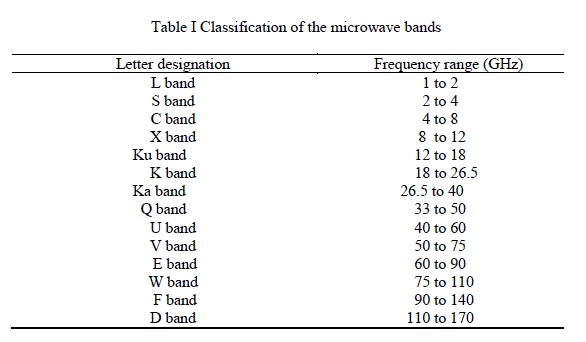 |
ALOE VERA |
| Aloe Vera also called as the Lily of desert means the plant which possesses exquisite properties for healing different
diseases [6]. Aloe Vera is a cactus-like plant that grows readily in hot, dry as well as humid climates and at present,
because of its demand, is cultured in large quantities [7]. The knowledge about the plant’s physiological, growth, and
yield responses under different conditions of stimuli is very limited. Although several plants are often used in, Aloe
Vera appears in some or the other form in most of the countries. The Aloe Vera species does not have any naturally
occurring populations; though the closely related Aloe Vera does occur in northern Africa [8]. Aloe Vera has a shallow
and spreading root system. The Aloe Vera plant has a crassulacean acid metabolism (CAM) .This mechanism allows
water conservation within the tissue, and hence resistance to high water stress [9]. It has several uses. Aloe Vera is
assumed to contain 75 potentially active constituents out of which are vitamins, minerals, enzymes, sugars, lignin,
salicylic acids, and amino acids [10]. Aloe Vera has extensive use in Ayurveda for its anti-burn effect and furthermore
as a tonic, antiseptic, antibiotic, anti-diarrheal, anti-viral, anti-fungal, anti-compliment and fine hair conditioner [11].
Aloe Vera also has some cooling properties similar to menthol which makes it great to sooth sunburns. Aloe Vera plant
gel is a lively ingredient in a number of different skin care products that facilitates to treat a wide variety of different
problems of skin. It also acts as a defensive layer on the skin and helps replenish its moisture. |
| A. Taxonomy and Etymology of Aloe Vera Plant |
| The Aloe Vera has been classified into Kingdom Plantae and Order Asparagales. It belongs to family
Xanthorrhoeaceae and sub family Asphodeloideae. The Aloe Vera species has number of synonyms A. barbadensis
Mill., A. vulgaris Lam, Aloe indica Royle and Aloe perfoliata L. var. vera [12].The common names include Indian
Aloe, Chinese Aloe, True Aloe, Burn Aloe and Barbados Aloe. The white spotted Aloe Vera is sometimes also known
as Aloe Vera war. [12]. Fig.1 shows Aloe Vera war. |
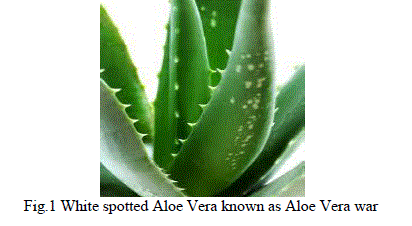 |
| B. Inner Fleshy Gel of Aloe Vera Plant |
| The other main ingredient of Aloe Vera is called gel, it is the inner fleshy layer .In other words it is the inner portion
of the leaves. It is clear, colourless, and tasteless. This gel contains 99% water and the rest is made of amino acids,
lipids, sterols, and vitamins. |
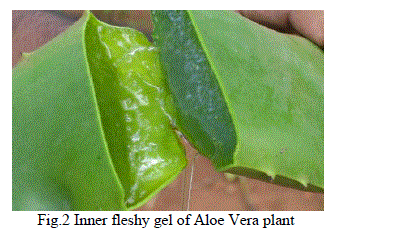 |
| Although the commercially available products are based on the gel, the British Pharmacopoeia does not have an
access for Aloe Vera gel but it does describe Aloes [13]. The Aloe gel has also been extensively used in gastrointestinal
disorders, including peptic ulcer, and its clinical usefulness [14-15]. |
| C. Use of Aloe Vera Plant |
| 1. The Aloe Vera has anti-microbial activity e.g. fungal, viral and bacterial, healing activity, it helps the body in
casting off dead tissues and stimulates the growth of new cells with little scar formation e.g. burns, analgesic
and anti-purity effects like arthritis, astringent effect (cosmetics), anti-inflammatory action (e.g. bee stings). |
| 2. Aloe Vera gel is used commercially as an ingredient available yogurt, lotions, beverages, and some desserts
[12]. |
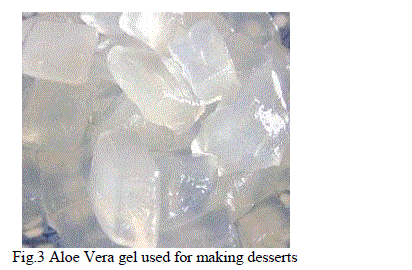 |
| 3. Aloe Vera is sometimes used on facial tissues to promote it as a moisturiser and anti-irritant to reduce rasping
of the nose of user who is suffering from hay-fever or cold [16]. |
| 4. In Arabian medicine, the Aloe Vera gel is used on the forehead as a remedy for headache as well as being used
for wound-healing, conjunctivitis, and as a disinfectant and laxative [17]. |
METHODOLOGY |
| The investigations were carried out on Aloe Vera plant to study the modification in the texture, colour and growth
due to effect of microwaves on it. In this research, the photograph of Aloe Vera leaf before microwave exposure was
taken and it was studied. After that the Aloe Vera plant was exposed to microwaves. The Klystron microwave test
bench as shown in Fig. 4 consisted of Klystron power supply, Klystron along with the fixed attenuator and CRO. |
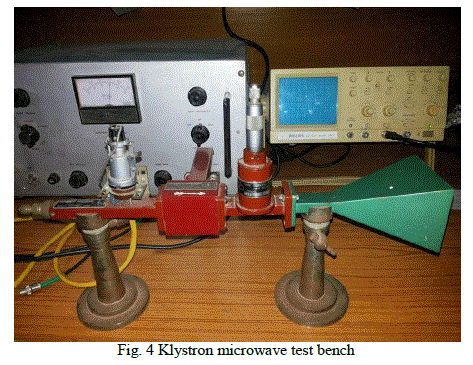 |
| Klystron is a specialized liner-beam vacuum tube which is used as an amplifier for high frequencies. The voltage
across the Klystron power supply was 300 V. After that Aloe Vera leaf was kept at a distance of 40 cm from the
Klystron transmitter antenna. The distance between the Aloe Vera leaf and the horn antenna was 5 cm. The length &
width of the horn was 15 cm & 10 cm respectively. The microwaves experimental setup can be explained in the Fig. 5
below. |
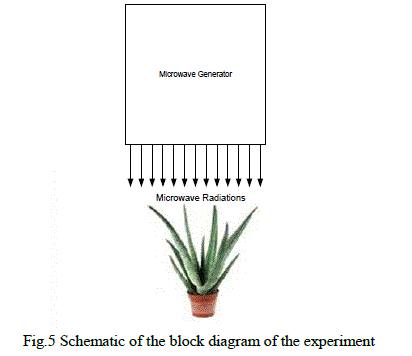 |
| The exposed Aloe Vera leaf was kept under natural environmental condition for ten days. The plant was watered
every day. The Aloe Vera leaf was observed with respect to change in physical properties like texture, colour and
growth. The texture and colour was observed by taking images of the Aloe Vera leaf and the growth was recorded by a
thick thread measured from the base of the leaf just above the root to the tip of the leaf. The setup to record the growth
of the Aloe Vera leaf is shown in Fig.6 and the estimation for the growth of Aloe Vera leaf is shown in Fig.7. |
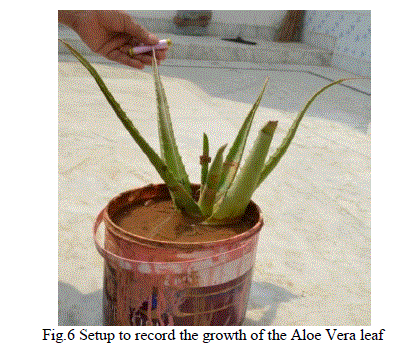 |
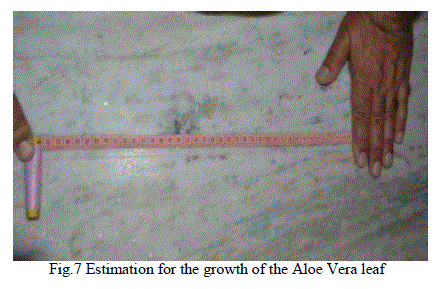 |
RESULT AND DISCUSSION |
| Investigations were carried out using both normal Aloe Vera leaf and microwave exposed Aloe Vera leaf for the
determination of the change in texture, colour and growth. The texture of the leaf was smooth and the colour was
natural green. The length was found to be 38 cm on the 1st Day with and without exposure. The analysis of the images
shows that the texture of the Aloe Vera leaf does not have any noticeable effect but the colour of the Aloe Vera leaf
was slightly faded to yellow green from natural green and the length of the leaf got shirked by 2 cm while the Aloe
Vera leaves which were unexposed to microwaves shown in Fig. 8 (a) which did not showed any notable change in
texture, colour and the growth. While Fig. 8 (b) to Fig. 8 (k) shows the images of the Aloe Vera leaf after the exposure
to microwaves. |
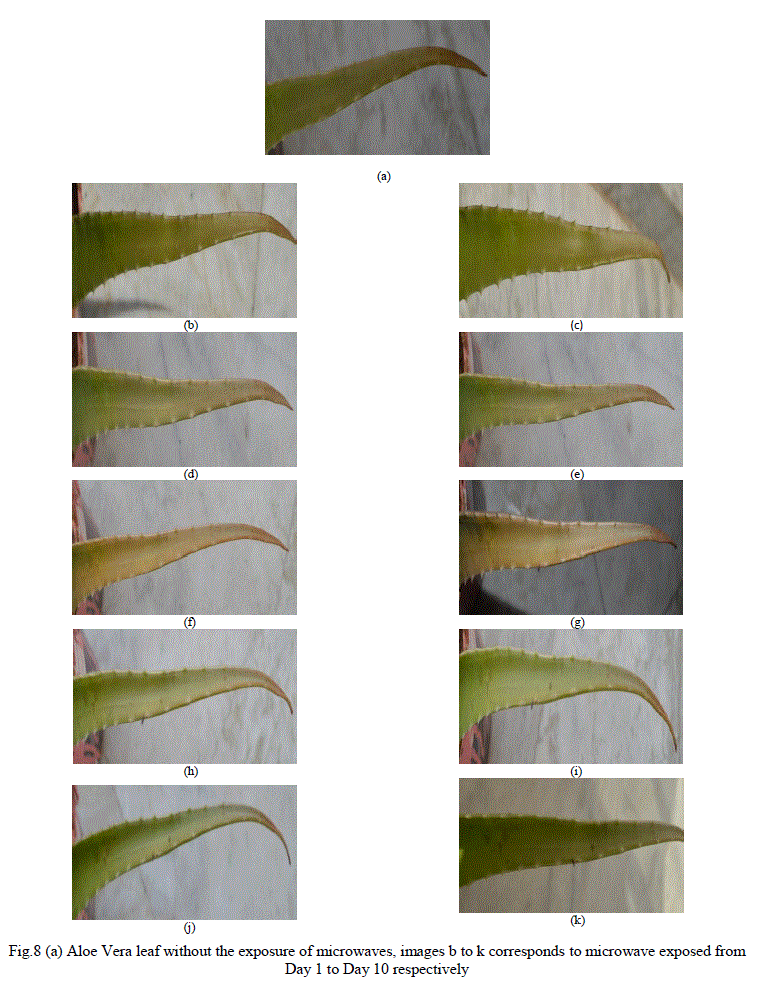 |
| The growth of the Aloe Vera leaf was recorded for ten days. The growth recorded is given in Table II below. The
recorded growth is also shown in Fig. 9 with the help of the graph. |
 |
| From the below graph it is clear that the growth of the Aloe Vera plant before the exposure of the microwaves was
38 cm. And then the leaf was exposed to microwaves and the growth of the leaf remained constant for first three days
at 38 cm. After that the growth was slightly decreased to 37 cm on fourth day and remained constant till sixth day. On
the seventh day the growth was again recorded and it was seen that it further got decreased by 1 cm and the new growth
was 36 cm till the end of the tenth day. This shrinkage may be due to the effect of microwaves on the Aloe Vera plant. |
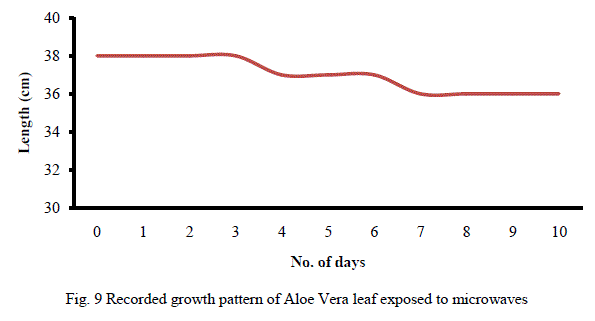 |
CONCLUSION |
| Experiments were carried out to study the effect of microwaves on the physical properties like texture, colour and
growth of the Aloe Vera Plant. The Aloe Vera leaf was exposed to microwaves. The analysis of the results showed that
the microwave exposure to the Aloe Vera leaf does not show any marked change in the texture but the colour of the
leaf was slightly faded from natural green to yellowish green. The leaf also got shrinked by 1 to 2 cms. On the other
hand the unexposed Aloe Vera leaves did not show change in the physical properties. Hence microwaves alter the
physical properties of the Aloe Vera plant. These results may be useful for researchers to evaluate the effects of
microwaves on Aloe Vera plants. Also, the investigations may be exceptionally important for the evaluation of the
health of the Aloe Vera and its leaves. |
ACKNOWLEDGEMENT |
| The authors are grateful to Ms. Sumaya Siddiqui for her indispensable technical support and valuable ideas. The
authors would like to express sincere gratitude and appreciation to their parents for their inspiration, guidance,
encouragement and everlasting love and care. |
References |
- Anna Aladjadjiyan, âÃâ¬ÃÅEffect of microwave irradiation on seeds of lentils (lens culinaris, med.)âÃâ¬ÃÂ, Romanian j. Biophys, vol. 20, pp. 221, 2010.
- Goldsmith, J. R., âÃâ¬ÃÅEpidemiologic evidence relevant to radar (microwave) effects, âÃâ¬Ã Environmental Health Perspectives, vol. 105, pp. 1587,1997.
- Ungureanu, E., Maniu, C. L., Smaranda, and Cretescu, V.I., âÃâ¬ÃÅConsideration on the peroxidase activity during hippophaerhamnoides seeds germination ex-posed to radiofrequency electromagnetic fieldiInflu-ence,âÃâ¬Ã Analelestiintifice ale Universitattii, AlexandruIoanCuza, Sectiunea Geneticasi Biologie Moleculara, pp. 34, 2009.
- Available Online: wikipedia.org/microwave_transmission.
- Macelloni, G., Paloscia, S., Pampaloni, P., and Ruisi, R., âÃâ¬ÃÅMicrowave Emission Features of Crops with Vertical Stems,âÃâ¬Ã IEEE transactions on geoscience and remote sensing, Vol. 36, 1998.
- Chopra, R. N., Nayar, S. L., and Chopra, I. C., Glossary of Indian Medicinal Plants, Council of Scientific and Industrial Research, 1992.
- Voglar, B. K., and Ernest, E., âÃâ¬ÃÅAloe Vera: A systematic review of its clinical effectiveness,âÃâ¬Ã British Journal of General Practice,âÃâ¬Ã vol. 49, pp. 828, 1999.
- Akinyele, B. O., and Odiyi, A. C., Comparative study of vegetative morphology and the existing taxonomic status of Aloe Vera L .,âÃâ¬ÃÂJournal of Plant Sciences vol. 2, 2007.
- RodrÃâôiguez, D., Jasso de RodrÃâôiguez, Gil-Margin, J. A., Angulo-SÃâôanchez, and Lira-Saldivar, J. L., âÃâ¬ÃÅGrowth, stomatal resistance, and transpiration of Aloe vera under different soil water potentialsâÃâ¬ÃÂ, sciencedirect, vol. 25, pp. 128, 2007.
- Atherton, P., âÃâ¬ÃÅAloe vera revisited,âÃâ¬Ã British Journal of Phytotherapy, vol.4, pp. 183, 1998.
- MedhaPrajapati, Patel, P. S., and Vyas, P. J., âÃâ¬ÃÅPhytochemical Analysis of Aloe Vera And Study of Mixing Antibiotic with Aloe Vera and Its Antibacterial Activity,âÃâ¬Ã Asian Journal of Biochemical and Pharmaceutical Research, vol. 1, 2011.
- Available online : http://en.wikipedia.org/wiki/Aloe_vera.
- Marshall, J. M., âÃâ¬ÃÅAloe Vera gel: What is the evidence?âÃâ¬Ã The Pharmaceutical Journal, pp.362, 1990.
- Kandil, A., and Gobran, W., âÃâ¬ÃÅProtection of Gastric Mucosa by Aloe vera,âÃâ¬Ã J. Drug Res. (Egypt), vol.11, pp.196 , 1979.
- Blitz, J. J, Smith, J. W., and Gerad, H. R., âÃâ¬ÃÅAloe veraGelin Peptic Ulcer Therapy: Preliminary Report,âÃâ¬Ã J. Amer.OsteopathicAssc.,vol. 62, pp.735,1963.
- Available online: Google search for Aloe Vera facial tissue Sept. 2009.
- Robson, M. C., Heggers, J. P., and Hagstrom, W. J., âÃâ¬ÃÅMyth, Magic, Witchcraft, or Fact? Aloe Vera Revisited,âÃâ¬ÃÂJournal of Burn Cure and Rehabilitation, vol.3, pp.163, 1982.
|